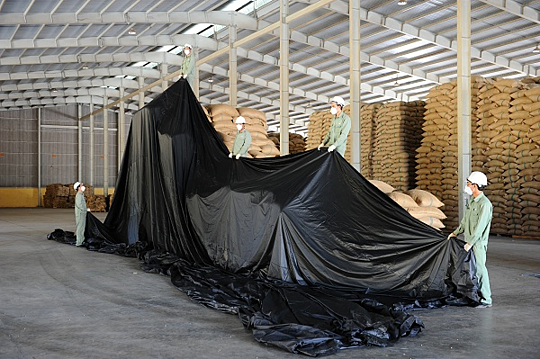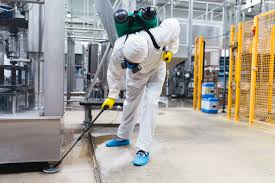WAREHOUSE PEST CONTROL: PREVENTING AND MANAGING COMMON PESTS
Pest prevention and control is now an integral part of sanitation for most warehousing and logistics properties – and for good reason. Contamination of raw materials and products by pest droppings, webbing and skin casts can lead to a loss of goods and revenue. Warehouses are particularly susceptible to pests as many insects and rodents will feed on goods and materials if left uncontrolled.
Potential consequences of a pest infestation in the warehousing & logistics industry, include:
- Termination of contracts leading to revenue losses;
- Prosecution for non-compliance with regulatory laws;
- Customer complaints;
- Increased costs for delayed treatments; and
- Loss of customer trust.

THINGS YOU SHOULD KNOW ABOUT WAREHOUSE PEST CONTROL MANAGEMENT
Here are some possible steps a warehouse owner can take to keep a warehouse safe from pest infestations. Initially to protect a warehouse pest evaluation is conducted in areas like rooms, utility rooms, storage, cafeterias, shipping places, janitorial cabinets, receiving places especially areas of shelters, food, and water resources are sealed to block wildlife and pest entry in these facilities. This evaluation is a critical part of effective pest control management. Further, building design is analyzed and evaluating existing structure, high traffic areas, and problem areas is the next crucial step. Areas like perimeters, water resources, dumpster, electrical conduits and storage areas are thoroughly inspected as well.
Different types of pests invade warehouses and each pest has unique habits and reaction. Therefore, treatment techniques are used accordingly, once basic information is gathered from the employees, an experienced professional knows what kind of products and techniques will be used to treat a specific pest infestation. For effective pest management program, experts further consider customized programs and different factors including building conditions, location, surrounding areas, weather and size of the building since each situation is unique and facilities in each warehouse are different from the other.
While hiring a pest control company, the warehouse owner must consider a certified and insured company that offers a quick response and follow certain standards necessary to maintain quality service. Professionals from the pest control company should have sound knowledge, experience, and history of serving warehouses

Ship Pests out of Your Warehouse
Here are some ways that commercial pest control services, can help warehouses with pest-related protocols and procedures:
Customized treatment plans and pest solutions for warehouse facilities can be designed to help minimize operational disruptions while effectively treating pests, such as rodents, flies, cockroaches, stored product pests, birds and others, commonly found in large spaces.
In addition to treating current pest problems, proactive prevention and monitoring strategies can help keep new infestations from establishing.
Commercial pest control professionals can help you make sure warehouses meet audit and regulatory requirements in regards to pest control, as well as help prevent pests from compromising packaging, product quality or sanitary conditions for workers.
Commercial pest control services can help reduce the operational disruptions and productivity losses that dealing with constant pest concerns can bring.
Help ensure your warehouse isn’t storing unwanted pests. With increasing protocols to manage, you’ve got enough on your plate without worrying about pests and related compliance issues. It’s easy to get a free estimate for commercial pest control services that can help allow you to focus on other warehouse management priorities.

Prevention Is the Best Warehouse Pest Control
Although there is no foolproof way of preventing pests from entering the warehouse, keeping your warehouse in good repair reduces the ways that rats, mice, roaches, birds, and other pests can get in. Some basic steps include:
- Ensuring that the roof is tightly sealed and leak-proof, doors close fully and tightly, and that any windows are also well sealed.
- Doing routine maintenance of plumbing and air conditioning to prevent leaks, which keeps pests from having a convenient supply of water to drink if they do make it into the warehouse and making it more difficult for them to breed.
- Cleaning your warehouse of any spilled food products and keeping tight control over employee food waste by allowing food only in designated areas and ensuring that trash is removed from these areas after each meal.
These basic procedures are all part of keeping a warehouse clean. And while they will help keep pests from entering the warehouse, they won’t close off a warehouse’s biggest vulnerability: shipments of product constantly entering the building. If a pallet full of packaged foods arrives, bringing the pests along with their food supply, then they will have the means to establish themselves in the warehouse in spite of all efforts to keep them out.
Plastic pallets can help prevent pests from using this route into your warehouse. Plastic shipping pallets have far fewer crevices that insects can use to conceal themselves than wood pallets, and unlike wood, they’re not a satisfying chew toy for rodents. Plastic is also nonabsorbent, and a plastic pallet is less likely to give pests a source of water that they can use to survive. Finally, it’s possible to wash and sanitize plastic pallets, which makes it much easier to control pests. All of these features give plastic pallets a clear advantage in preventing the transfer of pests between warehouses, saving your business money on extermination fees and wasted product, and, ultimately, on your Total Cost of Business (TCOB).
Physical Barriers and Building Design
In addition to this procedure, building design and physical barriers are crucial in preventing pest infestation. We’ve created a shortlist of important physical barriers you should consider when examining your premises for pest control purposes.
- Self-closing doors that show no light between the door seal and the jamb.
- The major entry door should have an ante-room which serves as a buffer and control zone for any pests that do breach the initial barrier.
- Positive pressure should also be maintained in processing and production areas. This provides a constantly outward moving air barrier to any flying insects and dust.
- Amenities should be connected to any production or processing areas with adequate fly-screens in the passage.
- Air curtains should be installed at external doorways and should have the capacity to move air across the entire doorway at 6m/s or faster. It is also important to check any ventilation systems or other ducts for pest ingress.
Those are just some of the physical barriers that you should either already have or be considering installing at your facility and when matched with an airtight pest control procedure should make your facility largely pest free.